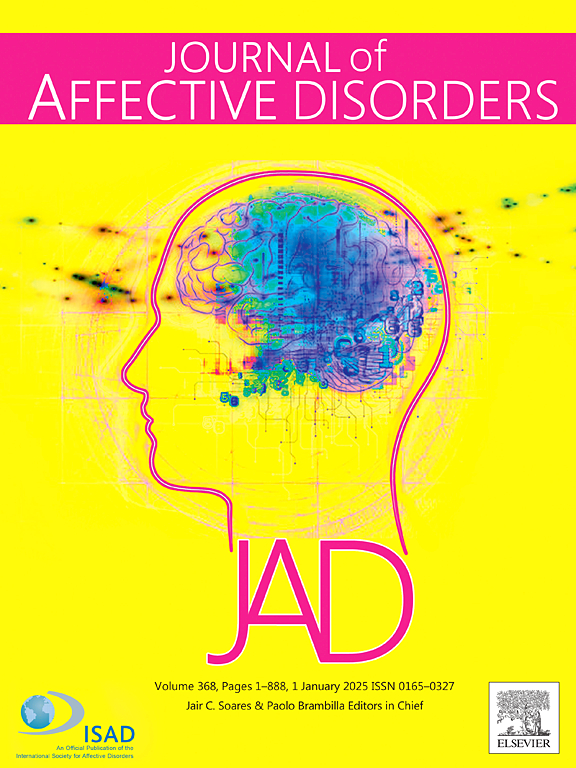The effects of melancholic features on the efficacy of high-frequency rTMS in adolescents and young adults with major depressive disorder
IF 4.9
2区 医学
Q1 CLINICAL NEUROLOGY
引用次数: 0
Abstract
Objective
This research examined the effects of neuronavigated high-frequency repetitive transcranial magnetic stimulation (HF-rTMS) on adolescents and young adults with major depressive disorder (AYA-MDD) with melancholic features. It also explored neuroimaging differences between melancholic (MD) and non-melancholic (NMD) AYA-MDD subtypes.
Method
Forty-four AYA-MDD participants (14 MD, 30 NMD) underwent 10 daily HF-rTMS sessions over two weeks. Resting-state fMRI scans were conducted pre- and post-treatment on 35 individuals (13 MD). The default mode network (DMN) was analyzed via independent component analysis (ICA). Depressive symptoms were measured using the HDRS-17 and three dimensions: somatic disturbances (SoD), core mood/anhedonia (CMA), and insomnia.
Result
SoD and insomnia improved significantly by week 1, while CMA showed improvement after two weeks. No between-group outcome differences were found. MD patients had baseline hyperactivity in the right frontal gyrus and hypoactivity in the right precuneus compared to healthy controls (HC). NMD patients showed right frontal gyrus hyperactivity and right cuneus hypoactivity relative to HC. MD patients also had greater right frontal gyrus activity and lower right precuneus activity than NMD patients. Post-treatment, MD patients exhibited increased left precuneus/cuneus activity, while NMD patients showed reduced left middle frontal gyrus/right angular gyrus activity. No correlations emerged between brain regions and HDRS-6 reduction.
Conclusion
Melancholic features may delay early HF-rTMS response, necessitating at least two weeks of treatment for core symptom relief. While pre/post-treatment brain changes differed between groups, DMN posterior region modulation appears central to rTMS therapeutic effects.
忧郁特征对青少年重度抑郁症高频rTMS疗效的影响
目的探讨神经导航高频重复经颅磁刺激(HF-rTMS)治疗具有忧郁特征的青少年重度抑郁症(AYA-MDD)的效果。它还探讨了忧郁症(MD)和非忧郁症(NMD) AYA-MDD亚型之间的神经影像学差异。方法44名AYA-MDD参与者(14名MD, 30名NMD)在两周内每天接受10次HF-rTMS治疗。在治疗前和治疗后对35名个体(13名MD)进行静息状态fMRI扫描。采用独立分量分析(ICA)对默认模式网络(DMN)进行分析。抑郁症状采用HDRS-17和躯体障碍(SoD)、核心情绪/快感缺乏(CMA)和失眠三个维度进行测量。结果sod和失眠在第1周明显改善,CMA在第2周明显改善。未发现组间结果差异。与健康对照(HC)相比,MD患者的基线右额回多动,右楔前叶低动。与HC相比,NMD患者表现为右侧额回多动和右侧楔叶少动。MD患者也比NMD患者有更大的右侧额回活动和更低的右侧楔前叶活动。治疗后,MD患者左侧楔前叶/楔前叶活动增加,而NMD患者左侧额叶中回/右角回活动减少。大脑区域与HDRS-6降低之间没有相关性。结论抑郁特征可能延迟早期HF-rTMS反应,需要至少2周的治疗才能缓解核心症状。虽然治疗前/治疗后各组之间的大脑变化不同,但DMN后区调节似乎是rTMS治疗效果的核心。
本文章由计算机程序翻译,如有差异,请以英文原文为准。
求助全文
约1分钟内获得全文
求助全文
来源期刊

Journal of affective disorders
医学-精神病学
CiteScore
10.90
自引率
6.10%
发文量
1319
审稿时长
9.3 weeks
期刊介绍:
The Journal of Affective Disorders publishes papers concerned with affective disorders in the widest sense: depression, mania, mood spectrum, emotions and personality, anxiety and stress. It is interdisciplinary and aims to bring together different approaches for a diverse readership. Top quality papers will be accepted dealing with any aspect of affective disorders, including neuroimaging, cognitive neurosciences, genetics, molecular biology, experimental and clinical neurosciences, pharmacology, neuroimmunoendocrinology, intervention and treatment trials.
 求助内容:
求助内容: 应助结果提醒方式:
应助结果提醒方式:


